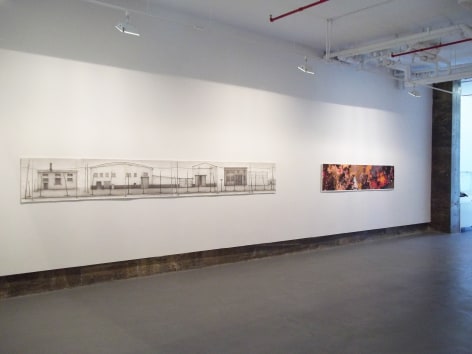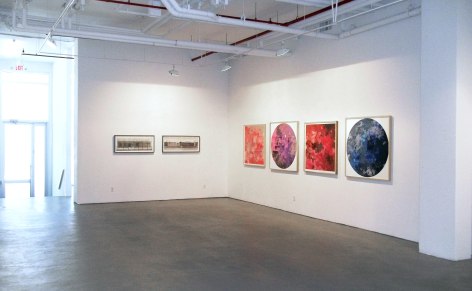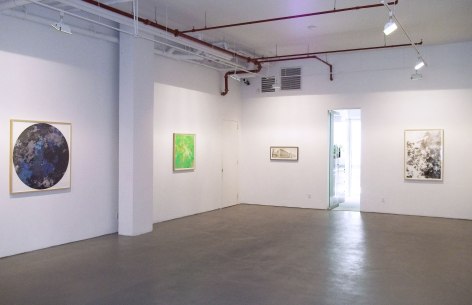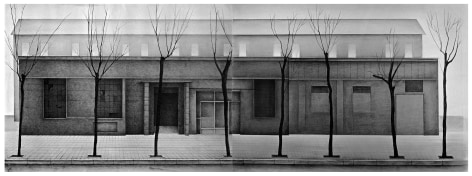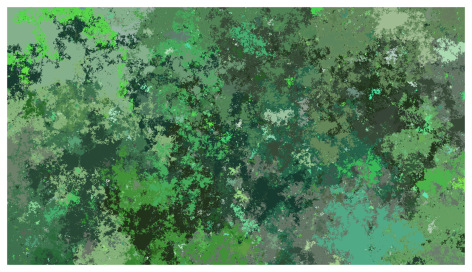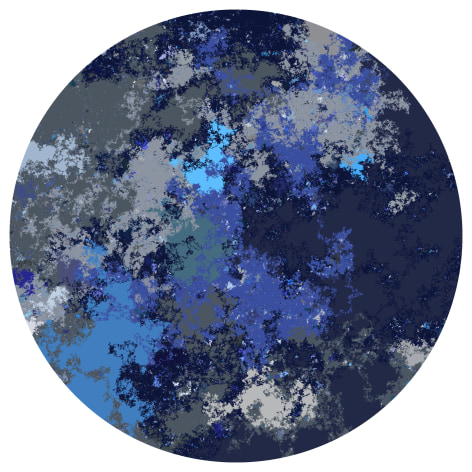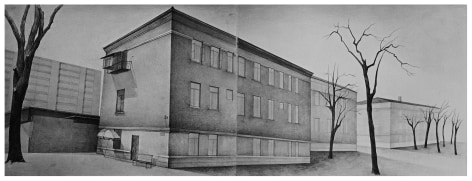Zhang Dun and Mi Mai are recent graduates from The Central Academy of Fine Arts, Beijing, in 2010 and 2008 respectively. Although both artists received the thorough training in academic techniques that is still required in Chinese art academies, they have clearly followed different paths, Zhang Dun choosing to continue a practice in which the handmade mark is of supreme importance while Mi Mai has rejected all aspects of traditional craftsmanship.
Zhang Dun’s pencil drawings are haunting for several reasons. As highly-finished as any academic showpiece, they are yet decidedly off-kilter in their representation of space. Vanishing–points shift from one sheet of paper to the next as she aligns them in a format reminiscent of Chinese scroll-paintings. Zhang Dun was born in Shenyang in Liaoning Province in Northeast China, a major industrial city, and has watched as once powerful industries have gone into decline, a process evident in the gradual deterioration of the physical structures that once housed them. After graduating from Lu Xun Academy of Fine Arts in Liaoning in 2003, she moved to Beijing and saw the entire process accelerated in the Dashanzi Art District (798) as it evolved from atmospheric decay to tawdry, shopping-mall chic in less than five years. Using her photographs as aides-mémoires, she eliminates all signs of life, people as well as vehicles, any sense of movement or specific historical period in order to create these drawings in which time seems to have stopped still.
In complete contrast are Mi Mai’s colorful ink-jet prints from the Random series. At first glance they appear to be abstract compositions designed above all to please rather than raise questions. To the extent that there is nothing disturbing about them, they are indeed pleasing to the eye although it is the issues they raise that make them interesting and create their aura. He graduated from the Department of Experimental Art at the Central Academy of Fine Arts, Beijing in 2008, having learned to question in his final year everything that he had been taught in the previous three. Naturally and not unusually, this included all the traditional skills he had mastered in the first year of his studies although more fundamental was the notion of control. How much control does the artist need to have over the production of his art? Total, some or none at all? In a sense, he was following in the footsteps of John Cage and Huang Yong Ping although his favored medium was shortly to become the computer and inkjet printer.
Recognizing early on that leaving all decisions to the computer would only result in random agglomerations of pixels, Mi Mai has created increasingly sophisticated programs which exercise a certain amount of control over colors, and shapes and the relationship between them. Varied in format as well as tonality, these dynamic compositions demonstrate that it is possible to create effects characteristic of works of art including harmony of composition and co-ordination of color through entirely mechanical means. The fact that it is by chance rather than intent that there are occasional reminiscences of Song Dynasty landscapes or Monet at his most daring in the latest development of the Random series is what makes them so intriguing.
艺术家张盾和米麦的作品,风格迥异,却貌离神合。张盾于1979年出生于辽宁沈阳。沈阳是一个工业发展极为迅速的地区,从新中国成立开始,政府多次对东北重工业的改革和振兴工程,在东北人生活和成长的记忆力,驻扎了几代人的情感记忆。工业化的烙印也深深地刻在了张盾的记忆中,在她作品中出现的铁西区就曾是沈阳一个非常雄厚的工业基地,随着新旧历史的更迭,面临改造,拆迁,一片片巨大而空旷的厂房被空置,荒芜而凄凉,带给人落寞的伤感和怀念,通过细腻的素描笔触刻画与渲染,传达出这些被人忽略而印象深刻的视角和氛围,使得她作品中有一种无形的震撼力。
米麦1982年出生于湖南株洲。与张盾细腻纯手工素描创作方式相比,他倾向于选择电脑等新媒体软件进行创作,他喜欢这种随机构成方式,这种无意识的创作会迸发出不一样的效果与形式美感。无意识是弗洛伊德精神分析学中的基本概念,他把人的心理世界分为三级,意识、前意识、无意识,无意识是本能欲望的领域,它的显现只是间接而隐蔽的,但不可忽视的是,它才是人的根本动力能源。在艺术领域,这种无意识的随机性被认作一种语言,这也是米麦想要诉说和表达的一个概念。
此次展览,两位艺术家将带来最新近的作品呈现。张盾更加注重作品本身的意义,在强调作品画面感方面也更直接,她想要将素描这一最为平常的刻画方式表达地更为至臻完美。米麦则尝试在一种特定条件下来表达“局部随机”概念,即在一种有所限制的条件下,比如在“□”或“○”这一局部中随机出颜色、面积和形状,这在本质上并不违背“随机”的整体概念,与他之前的创作相比,反而更加深化了这个题材的创作意义,也是他在此系列创作中的一个突破。
不久前,艾未未的《大理石之门》与斯勒佛特(Max Slevogt)于1914年创作的系列油画《埃及之旅图画》一同出现在德国的阿尔贝博物馆。一块虽表面无用武之地的大理石,艾未未却妙用了因其表面随机纹理酷似中国水墨山水画及中国传统龙形象而将其雕刻成一扇石门的艺术品。斯勒佛特,这位德国印象主义的代表人时常以行旅中的情绪来感染自己的灵感进行创作,他的埃及之旅绘画系列亦是源出于此。阿尔贝博物馆的馆长比苏夫(Ulrich Bischoff)将这两件作品安置于一起进行展示,他认为艾未未的石门与斯勒佛特油画置于一起展示不仅相互呼应,表达出东西方文化的同异,同时他更想表达的是这种不受时间、空间、地域和形式限制的艺术交流、作品与作品间的对话。其实,这就是求同存异。
张盾和米麦作品有很多不同点:在画面色彩上,张盾的素描黑白与米麦的随机赋彩;在选材方式上,张盾的特定选择和米麦的随机构成;在作品内容上,张盾的实景刻画与米麦的抽象表达。艺术家诸多的不同与对比却出现在同一个展览,而这正是前波画廊此次展览最想要表达的主题,求同存异的对话。


